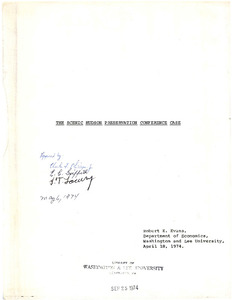| dc.rights.license | In Copyright | en_US |
| dc.creator | Evans, Robert Earl | |
| dc.date.accessioned | 2023-10-20T17:40:33Z | |
| dc.date.available | 2023-10-20T17:40:33Z | |
| dc.date.created | 1974 | |
| dc.identifier | WLURG038_Evans_thesis_1974 | |
| dc.identifier.uri | https://dspace.wlu.edu/handle/11021/36377 | |
| dc.description.abstract | On January 29, 1963 the Consolidated Edison Company of New York (hereafter referred to as Con Ed) [1] filed an application before the Federal Power Commission for a license to construct a pumped-storage hydroelectric project. The project was to be located some forty miles north of New York City in parts of the Village of Cornwall, the Towns of Highland Falls and Cornwall, and Orange and Putnam Counties, New York. The Cornwall Project, as it came to be called, was to have an initial output of 2,000,000 kilowatts (2000 Megawatts) making it the world's largest pumped storage facility. Licensing provisions provided for eventual expansion of the project to 3,000,000 Kw (3000 Mw). . . . The opposition to Con Ed's plans came from three different groups. The first group consisted of residents of Putnam, Westchester and Orange Counties who lived on the eastern side of the Hudson. They were opposed not so much to the powerhouse or to the reservoir as to the overhead transmission lines that would, they thought, deface their towns and destroy the beauty of their landscape. The question of the lines' lowering local property values was also a consideration. In the later stages of litigation, the Cornwall Project managed to attract the attention of a number of national conservation societies, among them: The Izaak-Walton League, The National Audubon Society, The Nature Conservancy, and The Sierra Club. Needless to say, local groups of the same genre joined in the fight to preserve Storm King: The Hudson River
Conservation Society, The Black Rock Fish and Game Club, The Westport Striped Bass Club, the Long Island Party Boat Owner's Alliance, The Scenic Hudson Preservation Conference and others. The last group to oppose the work at Storm King was a plethora of private individuals who were not members of one of the foregoing organizations but who were nonetheless actively interested in conservation efforts. [From Overview] | en_US |
| dc.format.extent | 254 pages | en_US |
| dc.language.iso | en_US | en_US |
| dc.rights | This material is made available for use in research, teaching, and private study, pursuant to U.S. Copyright law. The user assumes full responsibility for any use of the materials, including but not limited to, infringement of copyright and publication rights of reproduced materials. Any materials used should be fully credited with the source. | en_US |
| dc.rights.uri | http://rightsstatements.org/vocab/InC/1.0/ | en_US |
| dc.subject.other | Washington and Lee University -- Honors in Economics | en_US |
| dc.title | The Scenic Hudson Preservation Conference Case | en_US |
| dc.type | Text | en_US |
| dcterms.isPartOf | WLURG038 - Student Papers | en_US |
| dc.rights.holder | Evans, Robert Earl | en_US |
| dc.subject.fast | Scenic Hudson Preservation Conference | en_US |
| dc.subject.fast | Environmental policy -- Economic aspects | en_US |
| dc.subject.fast | United States -- Hudson River Valley | en_US |
| dc.subject.fast | Consolidated Edison Company of New York, inc. | en_US |
| local.department | Economics | en_US |
| local.scholarshiptype | Honors Thesis | en_US |
